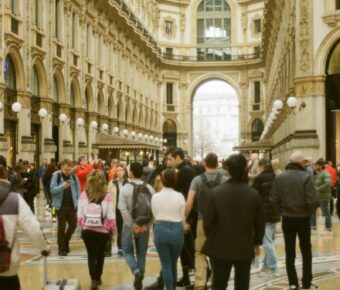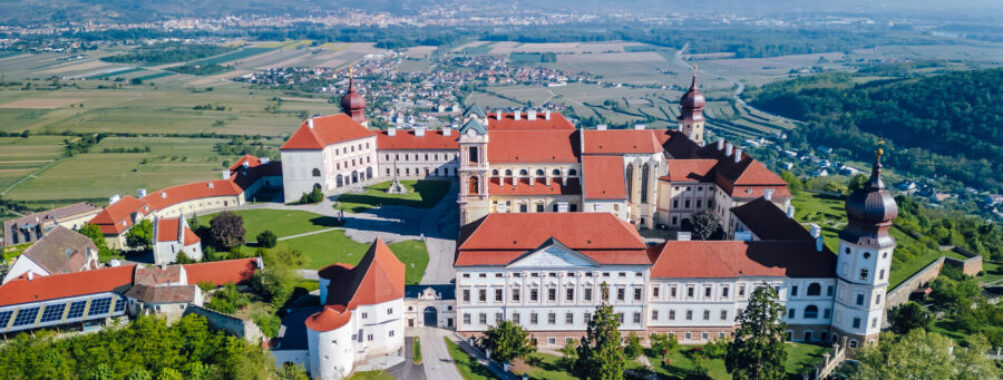
10 Hidden Treasures of Goettweig Abbey: Austria’s Spiritual Oasis in the Wachau Valley
Perched majestically above the picturesque Wachau Valley, Goettweig Abbey is a testament to nearly a millennium of spiritual devotion, artistic achievement, and cultural significance. While tourists flock to Vienna and Salzburg, this 900-year-old Benedictine monastery offers travelers an intimate glimpse into Austria’s rich religious heritage without the crowds.
One hour from Vienna, Goettweig combines spiritual tranquility, architectural splendor, and gastronomic delights in a UNESCO World Heritage setting. Discover why this hidden gem deserves a place on your Austrian itinerary—whether you’re seeking cultural immersion, architectural wonders, or an authentic taste of Wachau Valley wines.
Contents
- Quick Guide: Goettweig Abbey Weekend Escape
- The Spiritual Heart of the Wachau Valley
- Daily Rhythms of Monastic Life
- 2. Architectural Marvels: Where Heaven Meets Earth
- The Imperial Staircase: A Ceiling That Rivals the Sistine Chapel
- The Historic Library: A Bibliophile’s Paradise
- 3. Beyond Prayer: The Abbey’s Economic Enterprises
- Wachau’s Liquid Gold: Abbey Vineyards
- Marillen: The Golden Fruit of Wachau
- 4. Spiritual Renewal: Retreats and Programs
- Weekend Retreats: Finding Peace in Ancient Walls
- Youth Programs: Nurturing the Next Generation
- 5. Practical Planning: Your Goettweig Abbey Weekend
- Best Time to Visit
- Getting There & Around
- Where to Stay
- Estimated Costs
- Time-Saving Tips
- 6. Common Mistakes to Avoid
- Planning Pitfalls
- Experience Misses
- 7. Beyond Goettweig: Extending Your Wachau Valley Experience
- Dürnstein: The Ruins Where Richard the Lionheart Was Imprisoned
- Melk Abbey: Sister Monastery in Golden Splendor
- Wachau Cycling Path: Vineyards and Villages
- Krems Old Town: Medieval Charm and Culinary Delights
- 8. The Spiritual Souvenir: What You’ll Take Home
- Tangible Treasures
- Intangible Gifts
- 9. Seasonal Events Worth Planning Around
- 10. Sustainable Tourism at Goettweig
- Frequently Asked Questions About Goettweig Abbey
- Is Goettweig Abbey worth visiting?
- How much time do you need at Goettweig Abbey?
- How do I get from Vienna to Goettweig Abbey?
- Can you stay at Goettweig Abbey?
- What is special about Goettweig Abbey?
- When was Goettweig Abbey built?
- More Travel Guides
Quick Guide: Goettweig Abbey Weekend Escape
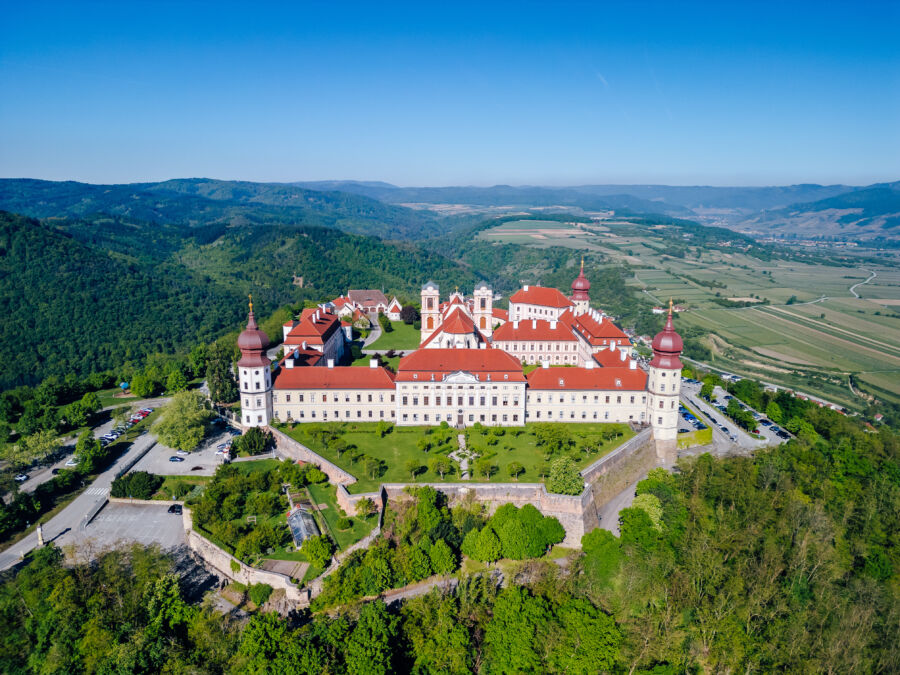
| Best For | Cultural travelers seeking spiritual connection and authentic Austrian experiences |
|---|---|
| Top Attractions | Magnificent fresco ceiling, 150,000-book library, Wachau Valley vineyards |
| Local Specialty | Marillen (apricot) products – brandy, juice, and dumplings |
| When to Visit | Summer (June-August) for perfect weather; September for harvest season |
| Budget | €400-600 for a weekend (mid-range accommodations, meals, activities) |
| Getting There | 1-hour drive from Vienna; train to Krems + bus/taxi |
| Ideal Duration | 2-3 days to fully experience the abbey and surrounding Wachau Valley |
| Perfect For | History buffs, wine enthusiasts, photographers, spiritual seekers |
The Spiritual Heart of the Wachau Valley
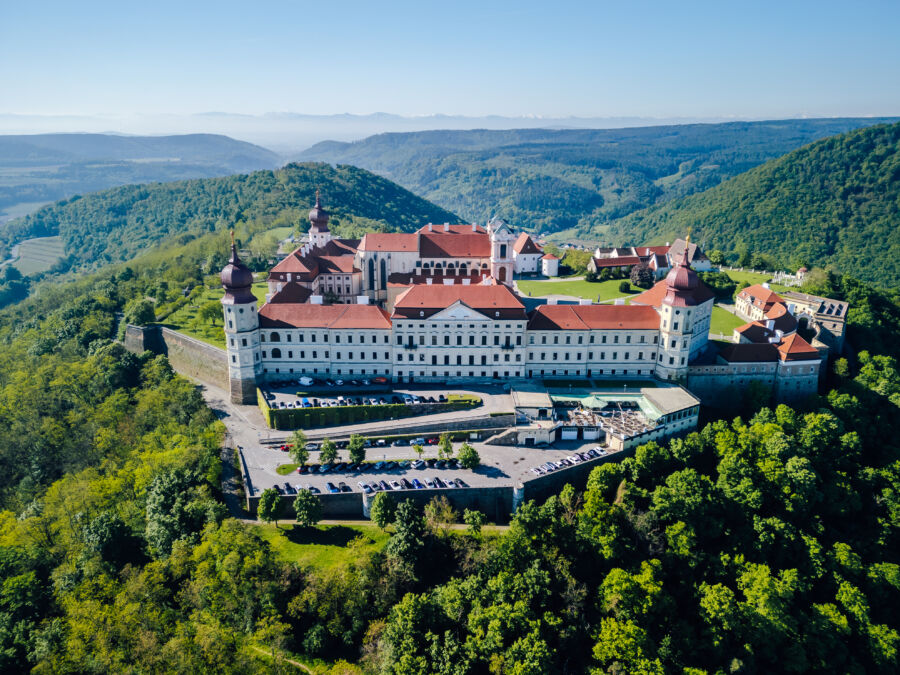
Goettweig Abbey isn’t just another stop on Austria’s tourist trail—it’s a living, breathing spiritual center where 14 Benedictine monks continue centuries-old traditions while meaningfully engaging with the modern world. Founded in the 11th century by Bishop Altmann, this magnificent complex has weathered wars, political upheavals, and societal changes while maintaining its core mission. The Rule of Saint Benedict—a 6th-century guide emphasizing the balance of prayer, reading, and work (“ora et labora”)—remains the foundation of daily life here.
Daily Rhythms of Monastic Life
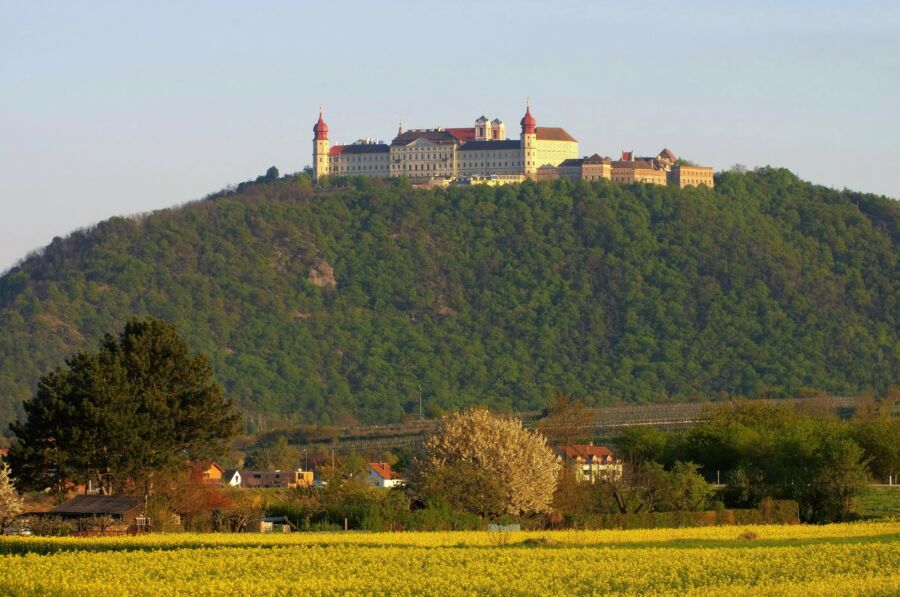
While most visitors only see the public areas, the monastery’s heart beats to an ancient rhythm behind normally closed doors. Your day at Goettweig offers a rare glimpse into this sacred world.
The monks begin their day at dawn with praise prayers in the intimate crypt chapel. Morning hours are devoted to contemplation and discussion before midday prayers. The spiritual cycle continues with evening vespers in the court chapel near founder Saint Altmann’s reliquary, concluding with night prayers in the ancient crypt.
Insider Tip: Time your visit to coincide with vespers (typically around 5:30 PM) for a deeply moving experience. While not typically open to tourists, respectful visitors may sometimes join this beautiful sung prayer service with advance permission.
2. Architectural Marvels: Where Heaven Meets Earth
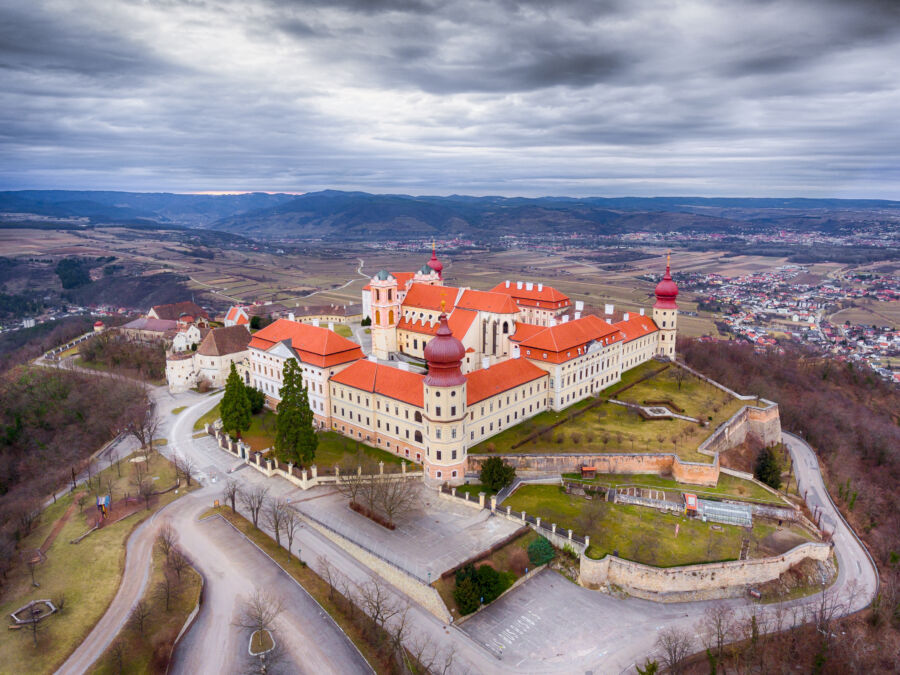
The moment you step into Goettweig Abbey, you’ll understand why it’s considered one of Austria’s baroque masterpieces—yet remains refreshingly uncrowded compared to more famous sites.
The Imperial Staircase: A Ceiling That Rivals the Sistine Chapel
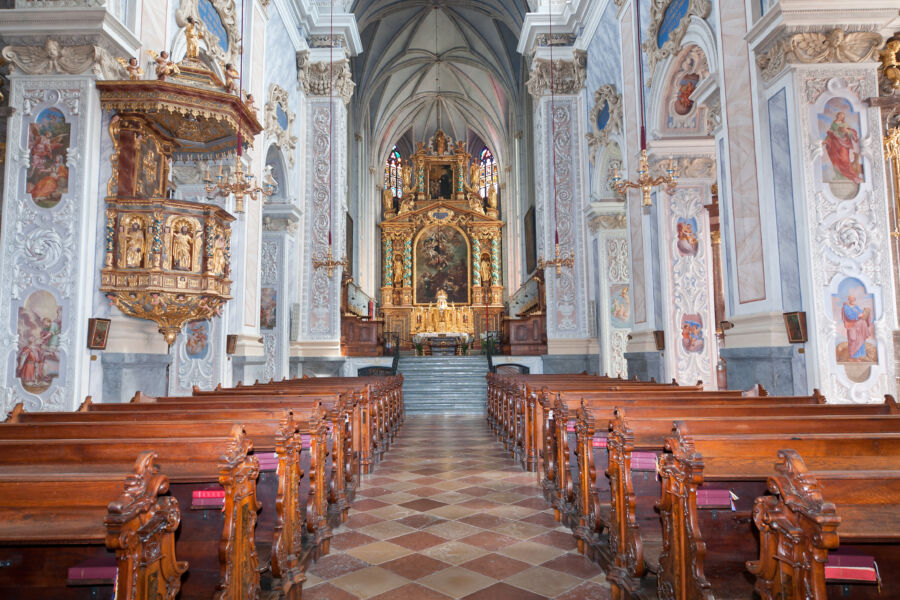
The undisputed highlight of any visit is the magnificent imperial staircase crowned by Paul Troger’s breathtaking ceiling fresco. Completed in 1739, this masterwork depicts Emperor Charles VI as Apollo in a stunning display of baroque theatricality that will leave you awestruck. What makes this experience special is the intimate setting—unlike the Sistine Chapel, you’ll rarely find yourself fighting through crowds to appreciate this artistic treasure.
The Historic Library: A Bibliophile’s Paradise

With an astonishing collection of 150,000 volumes, including manuscripts dating back to the 6th century, Goettweig’s library ranks among Europe’s most significant monastic collections. The ornate library hall is a work of art, with intricate wooden shelving and celestial ceiling decorations.
Photography Tip: The afternoon light streaming through the library’s windows creates a golden glow perfect for stunning photos. Bring a camera that handles low light well, as flash photography is prohibited to protect the ancient manuscripts.
See Related: Best Places to Visit in Austria: Your Ultimate Travel Guide
3. Beyond Prayer: The Abbey’s Economic Enterprises
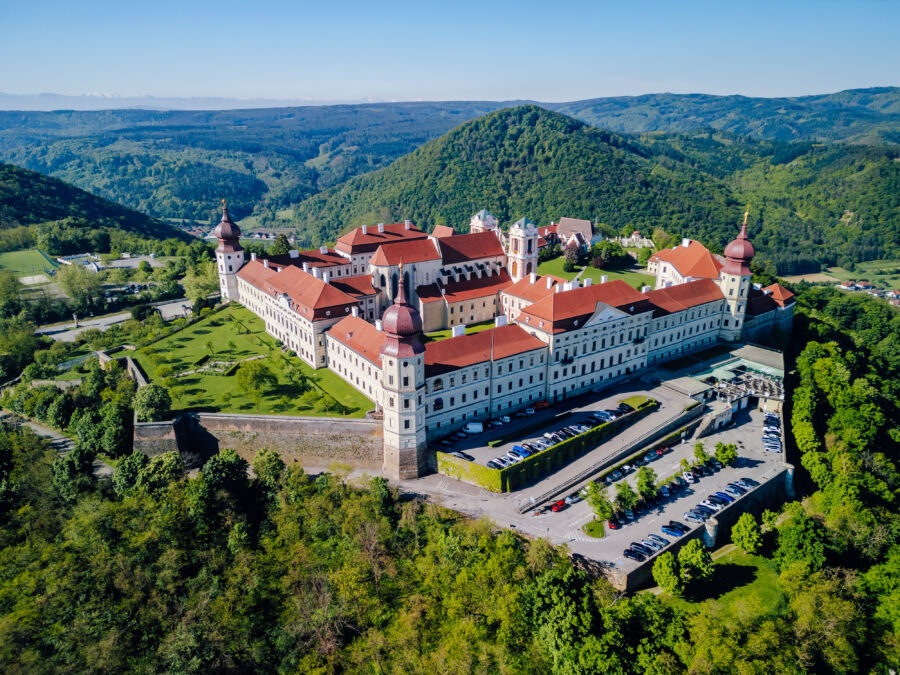
What distinguishes Goettweig from many religious sites is its continued economic engagement with the surrounding region—a centuries-old self-sufficiency model.
Wachau’s Liquid Gold: Abbey Vineyards

The sun-drenched slopes surrounding Goettweig are home to 64 vineyards producing some of Austria’s most distinctive wines. The abbey’s vintners specialize in:
- Grüner Veltliner – The region’s signature grape with crisp, mineral notes
- Riesling – Elegant, aromatic whites perfect with local cuisine
- Chardonnay – Full-bodied offerings with subtle oak influence
- Pinot Noir – Delicate reds showcasing the region’s terroir
Wine production here isn’t merely commercial; it’s a spiritual tradition dating back to the abbey’s foundation when wine was vital for mass and monastery operations. Today, these wines fund the monks’ community work while continuing an ancient craft.
Where to Taste: The abbey’s wine shop offers daily tastings featuring their signature bottles. For €15 per person, you can sample 5 varieties while overlooking the stunning Danube Valley. Their crisp, mineral-forward Grüner Veltliner (€14-22 per bottle) makes an excellent souvenir.
Marillen: The Golden Fruit of Wachau

The Wachau Valley is famous for its Marillen—small, intensely flavorful apricots that thrive in the region’s unique microclimate. The abbey has incorporated this local treasure into various exclusive products.
Must-Try Marillen Products:
- Marillenschnaps (apricot brandy) – €24
- Marillennektar (apricot juice) – €5
- Marillenknödel (apricot dumplings) – €8, served in the abbey restaurant during the summer months
- Marillenmarmelade (apricot preserves) – €6.50, perfect for bringing home
4. Spiritual Renewal: Retreats and Programs

Goettweig isn’t merely a historical monument—it’s a living center for spiritual growth and renewal, offering experiences for various interests and age groups.
Weekend Retreats: Finding Peace in Ancient Walls
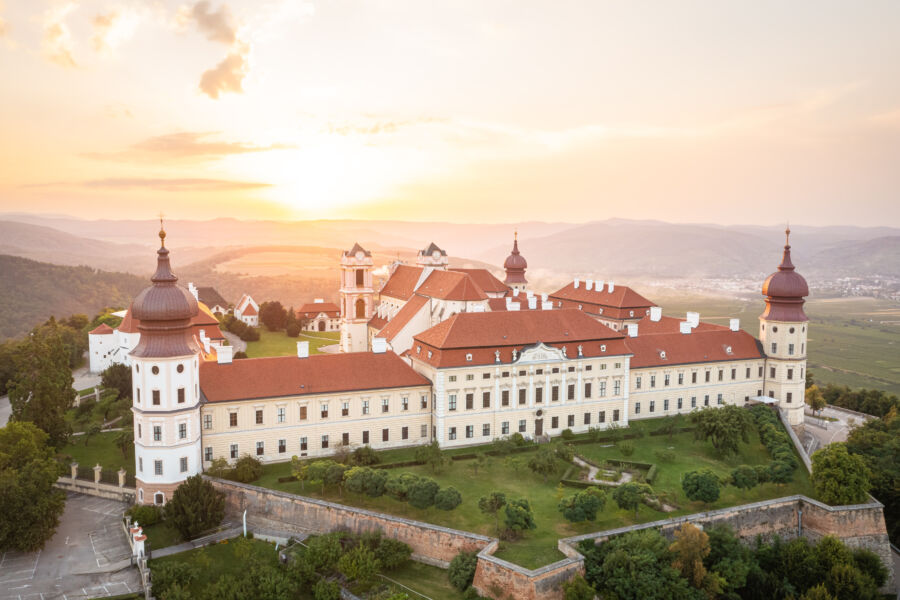
The abbey offers 3-5 day guided retreats for those seeking wisdom and tranquility. These programs include:
- Individual Spiritual Retreats (€280-350) – Personal reflection with monk guidance
- Silent Meditation Weekends (€300-400) – Contemplative practices in sacred spaces
- Relationship in Balance (€350 per couple) – Monthly retreats using Benedictine principles to strengthen partnerships
- Leadership & Wisdom (€400-450) – Professional development through monastic insights
All retreats include private accommodations, locally sourced meals, and structured sessions led by monks specialized in spiritual direction.
Booking Tip: Retreats fill quickly, especially for summer months. Reserve at least 8 weeks in advance through the abbey’s website or by emailing [email protected].
Youth Programs: Nurturing the Next Generation

The abbey hosts youth programs that combine fun activities with gentle spiritual guidance throughout the summer. While primarily designed for local Austrian families, international visitors with children can inquire about day programs that include:
- Medieval craft workshops
- Forest exploration adventures
- Abbey treasure hunts
- Simplified monastic prayers adapted for young participants
- Traditional Austrian cooking lessons
These programs offer children ages 8-16 a unique blend of historical learning, outdoor adventure, and gentle spiritual formation.
5. Practical Planning: Your Goettweig Abbey Weekend
Best Time to Visit

Summer (June-August): The peak season offers perfect weather for exploring the abbey and surrounding vineyards. The lush greenery of the Wachau Valley provides stunning backdrops for photos, and outdoor concerts are frequently held in the abbey courtyard.
Early Autumn (September): The grape harvest begins, and the surrounding forests display beautiful fall colors. Temperatures remain pleasant, and tourist crowds thin considerably after mid-September.
Spring (May or early June): Blooming apricot orchards create spectacular scenery and mild temperatures for hiking. Easter celebrations at the abbey offer special liturgical experiences.
Avoid: December-February can be extremely cold with limited opening hours, while April often brings unpredictable rain that can hamper exploration of the grounds.
Getting There & Around

From Vienna:
- By Car: The most convenient option, approximately 1 hour via the A1 motorway (€40-60 for weekend rental)
- By Train: Take the ÖBB train to Krems an der Donau (€22 round-trip, hourly service)
- Last Mile: Connect via local bus to Goettweig (€4, hourly until 6 p.m.) or taxi (€15, 10 minutes)
River Cruise Connection: Many Danube river cruises include Goettweig Abbey, an excursion from Krems. If you’re not on a cruise, you can still enjoy the Danube—local boat tours operate between Krems and Melk with stops near the abbey (€29 one-way).
Local Transportation: Once at the abbey, everything is walkable, but exploring the wider Wachau Valley requires transportation. Consider renting e-bikes in Krems (€30/day) for a delightful way to visit nearby vineyards and villages.
Where to Stay

The abbey itself offers limited accommodations for retreat participants, but these three nearby options provide excellent bases for exploration:
Hotel Unter den Linden (Krems, €120-150/night): This charming boutique hotel combines modern amenities with historic charm, situated perfectly for exploring both the abbey and Krems’ old town. Their “Abbey & Wine” package includes transportation to Goettweig and a wine tasting.
Winzerhof Petz (Krems, €110-130/night): A family-run winery with comfortable guest rooms overlooking their vineyards. Breakfast features homemade apricot preserves and local cheeses.
Gasthof Klosterberg (Just below the abbey, €90-110/night): Simple but comfortable rooms with unbeatable proximity to Goettweig. Their restaurant serves traditional Austrian cuisine using ingredients from the abbey’s farms.
Booking Tip: Reserve accommodations at least 2 months in advance for summer weekends, as the Wachau Valley is increasingly popular with knowledgeable travelers seeking alternatives to overtouristed destinations.
Estimated Costs
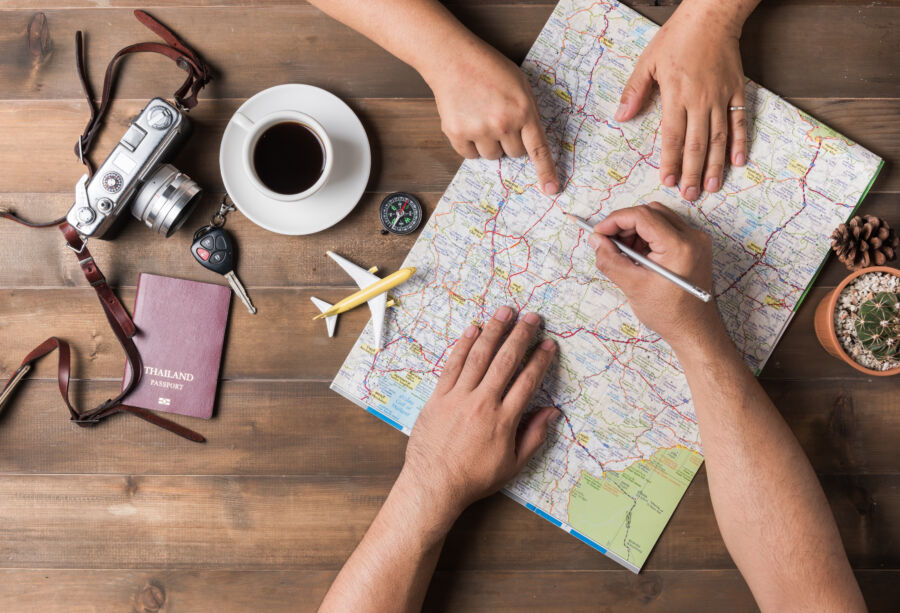
For a mid-range weekend experience (2 nights/3 days):
| Expense Category | Cost Range (€) | Notes |
|---|---|---|
| Accommodations | €200-300 | Double room, mid-range |
| Meals | €120-180 | Including one special dinner |
| Transportation | €80-120 | Rental car or public transit + local transport |
| Abbey Entrance & Tours | €35 per person | Guided tour and special exhibitions |
| Wine Tastings & Activities | €60-100 per person | Including souvenirs |
| Total per couple | €400-600 | Excluding flights to Vienna |
Time-Saving Tips
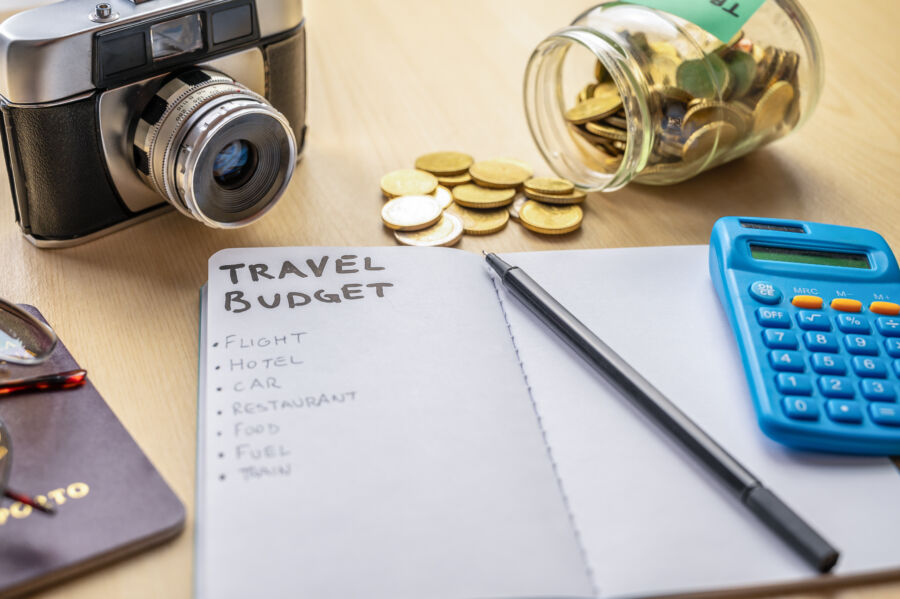
- Book the “Behind the Doors” tour in advance (€25 vs. the standard €12 tour) to gain access to normally restricted areas like the library and crypt.
- Visit on Friday rather than the weekend if possible—Saturday brings locals in addition to tourists.
- Start at the abbey first thing in the morning (8:30 AM opening), then explore the surrounding area in the afternoon when the abbey crowds peak.
- Pre-arrange a packed lunch from your hotel to enjoy on the abbey grounds, saving time and money versus the (excellent but busy) abbey restaurant.
6. Common Mistakes to Avoid
Planning Pitfalls

- Missing the fresco ceiling: Some budget tours skip the imperial staircase to save time, but this is the abbey’s crown jewel and worth the extra €5 entrance fee.
- Rushing through in an hour: Many visitors treat Goettweig as a quick photo stop. Allow at least 3 hours to truly appreciate the abbey’s treasures and atmosphere.
- Not checking the calendar: Occasional private events can restrict access to certain areas. Check the abbey’s official website before finalizing plans.
- Skipping the guided tour: While self-guided visits are possible, the detailed historical and cultural context provided by guides transforms your understanding of the site.
Experience Misses

- Overlooking the surrounding landscape: The views from the abbey terrace across the Danube Valley are spectacular—many visitors focus solely on interior spaces and miss this free highlight.
- Visiting only the abbey: The surrounding Wachau Valley is a UNESCO World Heritage site with charming villages, hiking trails, and wineries that complement the abbey experience.
- Missing wine-tasting opportunities: The abbey’s wines reflect centuries of viticulture tradition—skipping a tasting means missing a core part of Goettweig’s heritage.
- Forgetting your camera: The photographic opportunities at Goettweig and throughout the Wachau Valley are exceptional—come prepared with extra batteries and memory cards.
See Related: Best Places to Visit in Europe This Year
7. Beyond Goettweig: Extending Your Wachau Valley Experience

The beauty of Goettweig Abbey is that it sits at the heart of one of Austria’s most spectacular regions. Extend your stay to experience these nearby treasures:
Dürnstein: The Ruins Where Richard the Lionheart Was Imprisoned

Just 20 minutes from Goettweig, the blue-towered village of Dürnstein offers another historical treasure—the fortress ruins where England’s King Richard I was held captive during the Crusades. The moderate hike to the ruins rewards you with panoramic Danube views.
Don’t Miss: The blue-and-white tower of Dürnstein’s abbey church is one of the most photographed landmarks in Austria. Visit early in the morning for the best light and the fewest tourists.
Melk Abbey: Sister Monastery in Golden Splendor

While Goettweig offers intimate authenticity, nearby Melk Abbey presents baroque opulence on a grand scale. Art lovers should consider adding this complementary experience (30 minutes from Goettweig) to comprehensively understand Austrian monastic heritage.
Visitor Tip: Purchase a combination ticket (€30) for Goettweig and Melk Abbeys for €5 savings and faster entry at both sites.
Wachau Cycling Path: Vineyards and Villages

The flat, scenic cycling path connecting Krems and Melk makes for an ideal day activity between abbey visits. Stop at family wineries for tastings, discover hidden chapels, and enjoy riverside picnics in what many consider Austria’s most beautiful valley.
Recommended Route: Casual cyclists can complete the 42km Krems-Melk stretch in one day. For a more leisurely experience, ride one way and return by boat or train. NextBike offers rental stations in both Krems and Melk.
Krems Old Town: Medieval Charm and Culinary Delights

The nearby town of Krems features a beautifully preserved medieval center with winding streets, artisan shops, and excellent restaurants. For traditional Austrian cuisine and local wines, plan for dinner at Gasthaus Jell.
Shopping Highlight: The Wachau Valley Handicraft Market (Saturday mornings, April-October) showcases regional artisans selling everything from hand-carved wooden items to apricot-based beauty products.
8. The Spiritual Souvenir: What You’ll Take Home
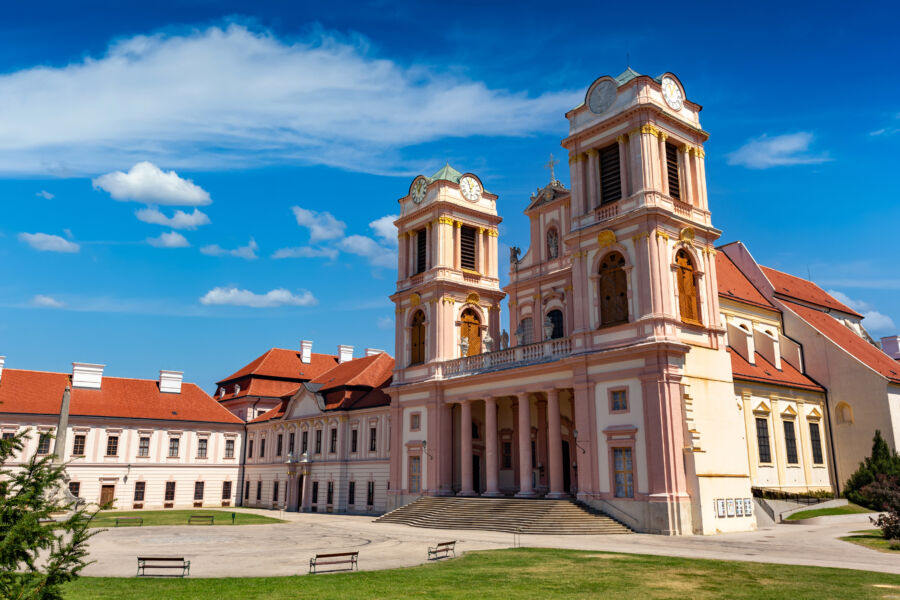
Beyond the bottles of Grüner Veltliner and jars of apricot preserves, Goettweig Abbey offers something increasingly rare in our hyperconnected world—genuine tranquility. The monks who have maintained this tradition for nearly millennia understand the modern soul’s hunger for peace and meaning.
Tangible Treasures
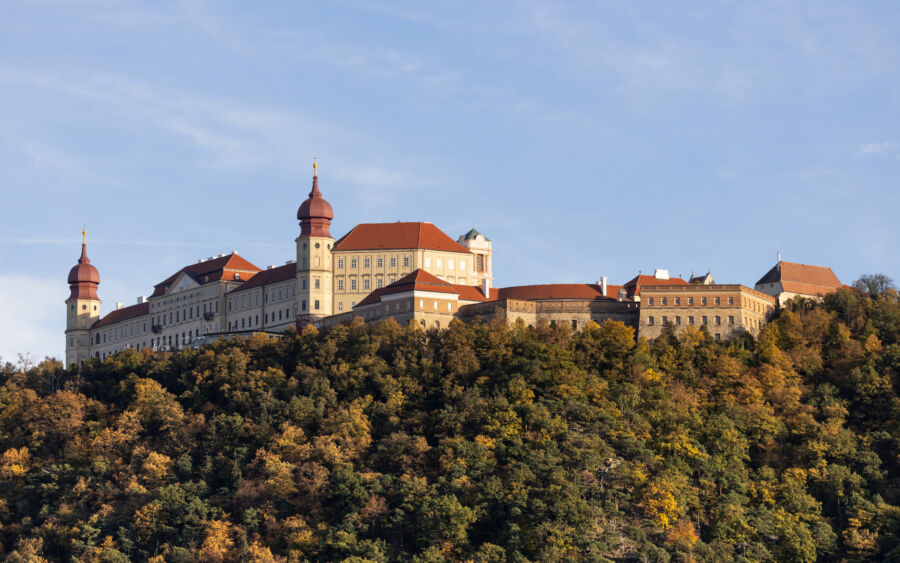
While memories are the most precious souvenirs, the abbey shop offers several distinctive items that capture the essence of your visit:
- Abbey Wines – Directly from their 64-acre vineyard (€14-32)
- Marillen Products – The apricot specialties that define the region
- Monastic Crafts – Handmade items created by the monks and local artisans
- Religious Items – Thoughtfully designed devotional objects and books
- Regional Specialties – Honey, jams, and other local delicacies
Intangible Gifts
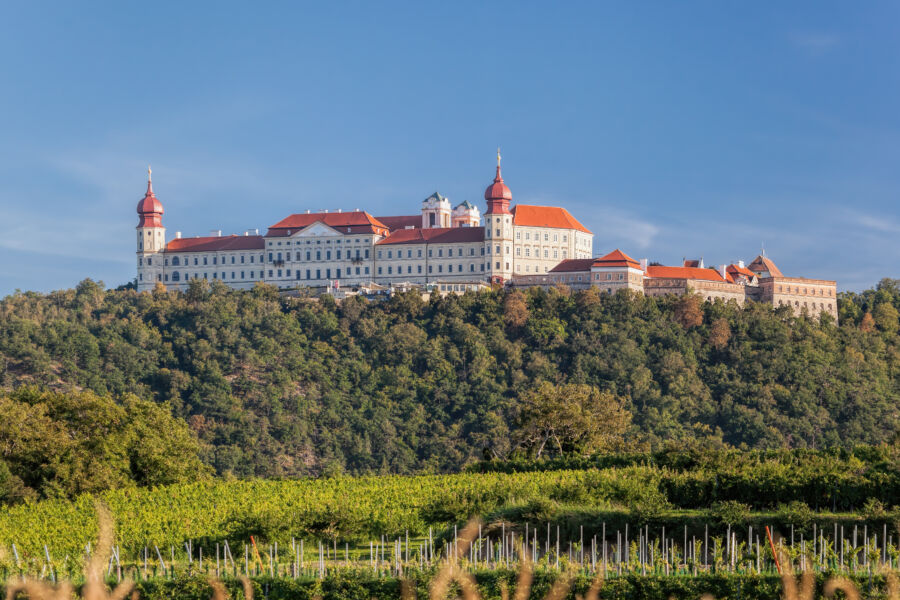
As you stand on the abbey terrace watching the sunset gild the Danube Valley, you’ll understand why travelers in the know have kept this spiritual treasure relatively secret. In a world of overtourism and Instagram hotspots, Goettweig remains where the inward journey is as meaningful as the journey there.
Whether you’re drawn by artistic masterpieces, viticultural excellence, or spiritual curiosity, this hidden gem of the Wachau Valley offers travelers a perfect weekend balance of cultural enrichment, natural beauty, and contemplative space—a truly sacred journey in every sense.
9. Seasonal Events Worth Planning Around

- Easter Week Celebrations (March/April) – Special liturgies and concerts
- Wachau Valley Wine Festival (Late May) – Regional wine celebration
- Summer Music Series (July-August) – Classical concerts in the abbey courtyard
- Marillen Harvest Festival (Mid-July) – Celebrating the apricot harvest
- Advent Market (Weekends in December) – Traditional Christmas market with local crafts
10. Sustainable Tourism at Goettweig

Goettweig Abbey has embraced sustainable tourism practices that allow visitors to enjoy its treasures while preserving them for future generations:
- Local Sourcing – Restaurant ingredients come primarily from abbey lands
- Waste Reduction – Comprehensive recycling and composting programs
- Energy Conservation – Historic preservation with modern efficiency
- Community Support – Tourism proceeds support the 30+ local parishes
- Cultural Preservation – Funding restoration of historical artifacts and buildings
By visiting Goettweig, you’re contributing to the ongoing preservation of this cultural treasure and the surrounding Wachau Valley ecosystem.
See Related: Historic Castle Hotels in Europe Where Medieval Dreams Meet Modern Luxury
Frequently Asked Questions About Goettweig Abbey
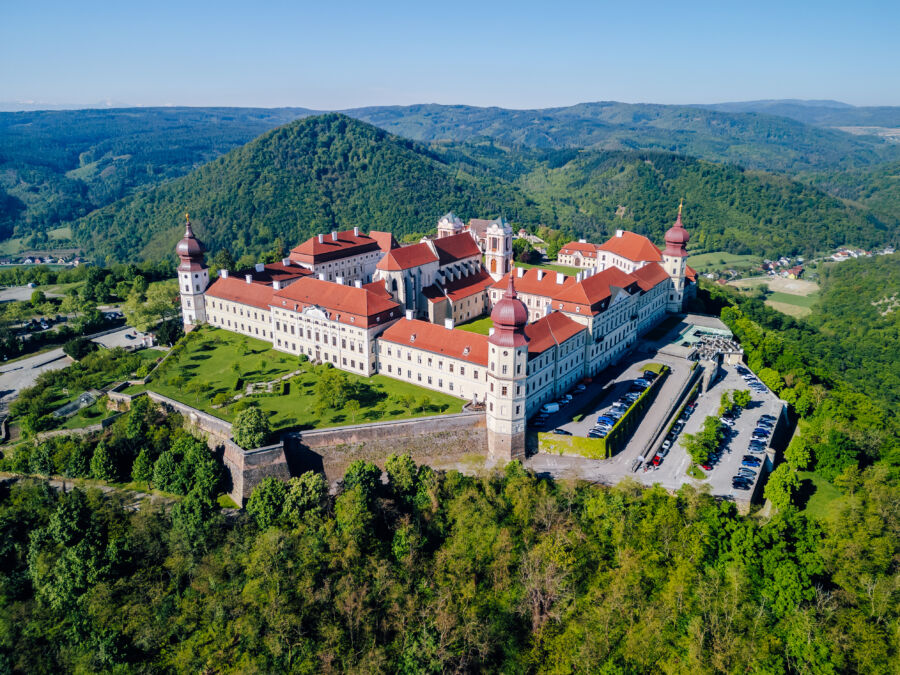
Is Goettweig Abbey worth visiting?
Yes, Goettweig Abbey is worth visiting for its stunning baroque architecture, magnificent frescoes, and panoramic views of the Wachau Valley. Unlike more crowded Austrian attractions, it offers an authentic monastic experience with fewer tourists and unique attractions, including a 150,000-volume historic library and excellent local wines.
How much time do you need at Goettweig Abbey?
Plan to spend at least 3-4 hours at Goettweig Abbey to fully appreciate its treasures. This allows time for a guided tour (90 minutes), exploring the museum and imperial apartments, enjoying the panoramic views, and perhaps a wine tasting or meal. For the complete experience, consider a full day to also explore the surrounding grounds and vineyard paths.
How do I get from Vienna to Goettweig Abbey?
The easiest way to reach Goettweig Abbey from Vienna is by car, which takes approximately one hour via the A1 motorway. Alternatively, take a train from Vienna to Krems an der Donau (hourly service, 1-hour journey), then connect via a local bus (€4) or taxi (€15, 10 minutes) to the abbey. Some Danube river cruises also include Goettweig as an excursion.
Can you stay at Goettweig Abbey?
While Goettweig Abbey does offer accommodation, it’s primarily reserved for retreat participants. However, excellent lodging options are nearby, including Hotel Unter den Linden and Winzerhof Petz in Krems or Gasthof Klosterberg, just below the abbey. For a truly monastic experience, inquire about the abbey’s retreat program, including overnight stays.
What is special about Goettweig Abbey?
Goettweig Abbey is special for its harmonious blend of spiritual tradition and worldly engagement. Highlights include Paul Troger’s breathtaking ceiling fresco in the imperial staircase, a historic library with 150,000 volumes, 64 acres of abbey-owned vineyards producing award-winning wines, breathtaking views across the UNESCO-listed Wachau Valley, and the opportunity to experience a living 900-year-old Benedictine community.
When was Goettweig Abbey built?
Goettweig Abbey was founded in 1083 by Bishop Altmann of Passau. Following a devastating fire in 1580, the Romanesque buildings significantly expanded during the Baroque period. The magnificent imperial wing, with its famous staircase and fresco ceiling, was completed in 1739, creating the impressive complex visitors see today.
Ready to experience Goettweig Abbey and the Wachau Valley? The ideal months for visiting are June through early September, when the weather is perfect for exploring the historical interiors and the surrounding vineyards. Book accommodations for summer weekends for at least 8 weeks to secure the best options in this increasingly popular region.
Contact the visitor center directly at [email protected] or their official website for personalized abbey tour information.



